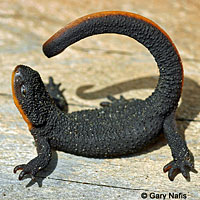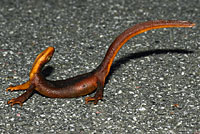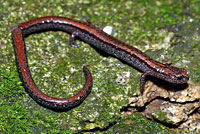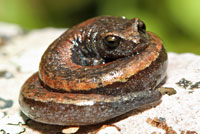Salamander Behavior and Life History -
Defensive Strategies


| Defense | ||
 |
 |
 |
| When they feel threatened by another animal, Rough-skinned Newts sometimes assume a defensive posture called an Unkenreflex. They arch their backs and tails, raising their head to expose a brightly colored underside which signals that they are poisonous to eat. This response is often triggered when they are picked up or when their back is touched. | This short video shows a Rough-skinned Newt assuming a defensive posture, but without curling its tail as it usually does. | |
 |
 |
 |
| A Sierra Newt in a defensive pose. | California Newts assuming a defensive pose. | |
 |
 |
 |
| Be careful when handling Arboreal Salamanders. They have sharp teeth and aren't afraid to use them! Mike Spencer found it, Val Johnson took the pictures, and Shannon Hoss inadvertently donated some blood when she picked up this toothy beast in Mendocino County. © Val Johnson |
Adult Speckled Black Salamander in what appears to be an "unken reflex" defensive pose. © Grayson Sandy | |
 |
 |
 |
| Two adult male Arboreal Salamanders locked in bloody combat. © Sasha Robinson. The picture on the far right was taken about an hour after the first two pictures and they were still fighting. | ||
 |
 |
 |
| Northwestern Salamanders with white secretions. Northwestern Salamanders have parotoid glands on their heads, backs and tails. When they are threatened, they put their head down in a defensive posture and release a white poisonous fluid from these glands. Sometimes they will butt their head and lash their tail to smear the poison on an attacker. This poison can kill or sicken small animals and causes skin irritation in some people. | A Larch Mountain Salamander sitting on a rock becomes alarmed and runs while quickly writhing its body back and forth until it rolls itself into a ball and rolls down off the rock where it bounces off another rock and springs and rolls again until it lands safely. This amazing escape behavior, developed as a defense for survival on steep rocky slopes, is shown in real time, then slowed down for a better look. The Limestone Salamander also curls itself up to roll away to safety. |
|
 |
 |
 |
| Sierra Nevada Ensatina © Tim Burkhardt |
Oregon Ensatina | Yellow-eyed Ensatina |
 |
 |
 |
| Painted Ensatina | ||
 |
 |
 |
| Yellow-eyed Ensatina © Alex Castelein | Monterey Ensatina | |
| When threatened, Ensatinas assume a defensive pose with their bodies raised up off the ground and their tails elevated. They release a milky white poisonous fluid from glands on their tail and head to deter predators. | ||
 |
 |
 |
| The best defense is camouflage. Looking at the Santa Cruz Long-toed Salamander on the left and the willow leaf on the right you can see how the pattern on the salamander helps it blend into its environment to remain undetected. © Ryan Sikola |
Other salamanders in California have similar random scattered patterns that help them blend into the fallen leaves, branches and pine needles of their environment such as the Yellow-blotched Ensatina above left and the Sierra Nevada Ensatina above right. | |
| Autotomy | ||
| When a salamander is feeling threatened, it will sometimes drop its tail, often after the tail has become injured or broken in a struggle with a predator. This is referred to as caudal autotomy. Once removed from the body, the tail will wiggle frantically for several minutes, distracting a predator long enough for the salamander to crawl away slowly, or to remain still enough that it is no longer seen by the enemy. Male salamanders will sometimes fight each other by biting their opponent's tail, which also accounts for missing tails. This tail detachment does not harm the salamander. It will survive and grow a new tail, but the salamander is at a disadvantage since it has lost an important defense mechanism, as well as energy stored in the tail, and any perceived size advantage it may have had in protecting its territory or attracting a mate. So always handle salamanders (and lizards) carefully and avoid stressing an animal to prevent the tail from breaking off. I have seen many lizards in the wild with missing or regenerated tails, but few salamanders. This purely anecdotal data leads me to believe that it is not as common for salamanders to lose their tails as it is for lizards. It's also be possible that salamanders with missing tails do not survive as well as lizards with missing tails and therefore I don't find them. |
||
 |
 |
 |
 |
 |
 |
| In the first four pictures of the series above, an adult Greenhorn Mountains Slender Salamander was photographed after being placed on a moss-covered rock as it was writhing about and shaking its tail rapidly until the tail finally broke off and continued wiggling on its own. The broken end of the detached tail is also shown above. The flash stopped the motion of the salamander making it look like it is sitting still, but it was moving back and forth rapidly. |
||
 |
 |
 |
| Sometimes a tail regenerates in two forks or, as it looks like has happened to this California Slender Salamander, a new tail will start growing where a tail is damaged even when the original tail heals and doesn't break off. © Zach Lim |
In this short video as I lift a fallen branch with a Gregarious Slender Salamander underneath it, the salamander's tail comes off and begins wriggling on the ground. This is a defensive tactic used to distract a predator towards the moving tail and away from the animal which remains still. The salamander may have intentionally released its tail here, or it could have just been a result of lifting the log. I pick up the tail and you can see an edited version of it slowly wriggling to a stop. | This Yellow-eyed Ensatina was found with a missing tail. The tail is easily broken off, and sometimes it will be released by the salamander to distract a predator, but it will grow back. |
 |
 |
 |
| This Arboreal Salamander has lost the end of its tail recently because it has not yet started to grow back. | You can see what a regenerating tail looks like on the end of the tail of this Gabilan Mountains Slender Salamander. | This San Simeon Slender Salamander has a broken and regenerating tail that almost gives it the appearance of having two heads. |
 |
 |
|
| This White-spotted Slimy Salamander is missing most of its tail. | Something took off the end of the tail on this Red-Cheeked Salamander. | |
Return to the Top
© 2000 -
